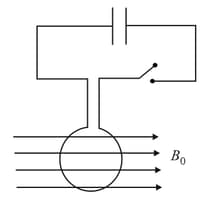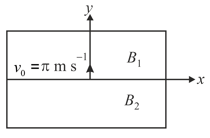Consider two identical galvanometers and two identical resistors with resistance . If the internal resistance of the galvanometers which of the following statement(s) about any one of the galvanometers is(are) true ?

Important Questions on Magnetic Effects of Current and Magnetism
In a thin rectangular metallic strip a constant current I flows along the positive x - direction, as shown in the figure. The length, width and thickness of the strip are l, w and d, respectively. A uniform magnetic field is applied on the strip along positive y - direction. Due to this the charge carries experience a net deflection along the z-direction. This results in accumulation of charge carriers on the surface PQRS and appearance of equal opposite charges on the face opposite to PQRS. A potential difference along the z - direction is thus developed. Charge accumulation continues until the magnetic force is balanced by the electric force. The current is assumed to be uniformly distributed on the cross section of the strip and carried by electrons.

Consider two different metallic strips (1 and 2) of the same material. Their lengths are the same, widths are and and thicknesses are and , respectively. Two points and are symmetrically located on the opposite faces parallel to the - plane (see figure). and are the potential differences between and in strips 1 and 2 respectively. Then, for a given current flowing through them in a given magnetic field strength , the correct statement(s) is (are)
In a thin rectangular metallic strip a constant current I flows along the positive x - direction, as shown in the figure. The length, width and thickness of the strip are l, w and d, respectively. A uniform magnetic field is applied on the strip along positive y - direction. Due to this the charge carries experience a net deflection along the z-direction. This results in accumulation of charge carriers on the surface PQRS and appearance of equal opposite charges on the face opposite to PQRS. A potential difference along the z - direction is thus developed. Charge accumulation continues until the magnetic force is balanced by the electric force. The current is assumed to be uniformly distributed on the cross section of the strip and carried by electrons.

Consider two different metallic strips (1 and 2) of same dimensions (length , width and thickness ) with carrier densities and , respectively. Strip 1 is placed in magnetic field and strip 2 is placed in magnetic field , both along positive -directions. Then and are the potential differences developed between and in strips 1 and 2 respectively. Assuming that the current is the same for both strips, the correct option(s) is (are)
A circular coil of radius and turns has negligible resistance. As shown in the schematic figure, its two ends are connected to two wires and it is hanging by those wires with its plane being vertical. The wires are connected to a capacitor with charge through a switch. The coil is in a horizontal uniform magnetic field parallel to the plane of the coil. When the switch is closed, the capacitor gets discharged through the coil in a very short time. By the time the capacitor is discharged fully, magnitude of the angular momentum gained by the coil will be (assume that the discharge time is so short that the coil has hardly rotated during this time)


